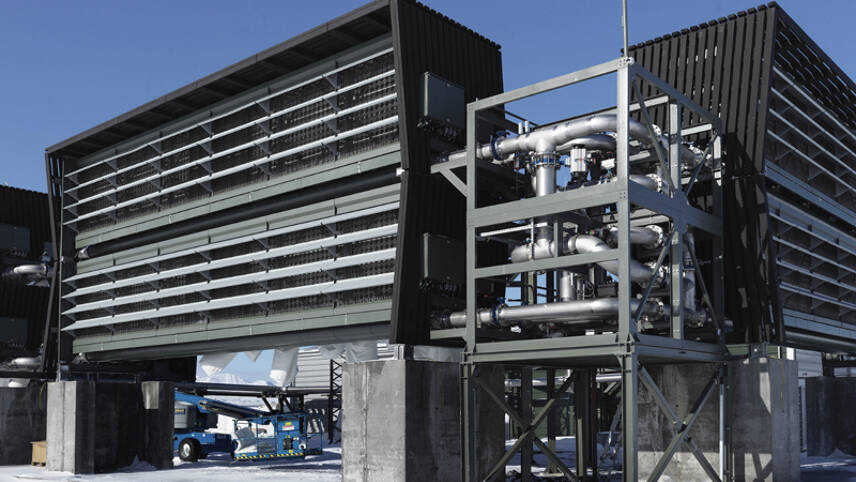Register for free and continue reading
Join our growing army of changemakers and get unlimited access to our premium content

Pictured: Climeworks' Orca direct air capture plant in Iceland. Image: Climeworks
The tech giant first announced an intention to source carbon removal solutions from Climeworks in January 2021, a year after pledging to achieve carbon-negative operations and supply chains by 2030. To achieve this 2030 goal, Microsoft – which is already carbon-neutral in operations – intends to halve emissions this decade and invest to offset and remove more carbon than it emits annually.
This week, Climeworks confirmed that it has entered into a ten-year purchase agreement with Microsoft. The investment in the deal has not been disclosed at this stage, but Climeworks claims it is “one of the largest” in the DAC space and will support the removal of “tens of thousands of tonnes of carbon dioxide from the atmosphere”.
“Microsoft’s multi-year offtake agreement with Climeworks is an important step towards realizing the ‘net’ in net zero,” said Microsoft’s chief environmental officer Lucas Joppa. “Our experience in purchasing renewable energy shows that long-term agreements can provide an essential foundation for society’s race to scale new decarbonisation technologies.”
Other corporate supporters of Climeworks include Ocado, Swiss RE, Audi, LGT and Stripe, the latter of which is spearheading a collaborative private sector commitment on scaling carbon capture technologies. Called ‘Frontier’, the collaboration is backed by $925m of commitments to purchase carbon removals using man-made technologies this decade.
Technology scale-up
Climeworks currently operates 17 DAC plants, including one, Orca, which is operating on a commercial basis. Orca came online in September 2021 and is based in Hellisheiði, Iceland. Its CO2 removal capacity is 4,000 tonnes per year.
Last month, Climeworks confirmed plans for its 18th and largest plant to date – Mammoth, also in the same Icelandic region. The plant is expected to begin operations in either late 2023 or early 2024. In the first instance, it will have a CO2 capture capacity of 36,000 tonnes per year. Climeworks is aiming to scale to two megatonnes of capacity by 2030, laying the foundations for scaling to a gigatonne of capture capacity by 2050.
Climeworks’ technology works by drawing air into a collector with a fan. Inside the collector, CO2 is filtered out. When the filter is full, the collector is closed and heated to release the CO2, ready for concentration and storage by storage partner Carbfix. The carbon associated with developing and operating the DAC facilities, Climeworks claims, is typically equivalent to 10% of the carbon that will be captured. This calculation considers the fact that the facilities are powered by renewable energy.
Microsoft’s Joppa has called DAC “a nascent but crucial industry” to achieve the halving of net global emissions by 2030 and bringing them to net-zero by 2050 – the levels recommended by the Intergovernmental Panel on Climate Change (IPCC) for giving humanity the best chance to limit the global temperature increase to 1.5C.
Indeed, some climate scientists have concluded that large-scale carbon capture – whether man-made or nature-based – is needed at scale to avert the worst physical impacts of climate change due to historic and continuing emissions. The IPCC itself has stated that, by 2050, the world’s air-based carbon removal capacity should be 3-12 billion tonnes in a net-zero world.
However, as Joppa acknowledged, man-made systems are in their relative infancy commercially. Critics are concerned that they may not deliver their promised benefits and could be used as a means for businesses to avoid reducing their emissions in the first instance.
ETC report
In related news, the Energy Transitions Commission (ETC) has this week published a new report outlining its recommendations for scaling carbon capture, storage and utilisation (CCUS) technologies while ensuring that efforts around zero-carbon electricity and emissions reductions are not de-prioritised.
That report forecasts that, in 2050, the world will need 7-10 gigatonnes of CO2 capture. This is at the higher end of the levels recommended by the IPCC. Reaching this scale, the ETC argues, cannot be dependent on action in the mid or long-term – concerted efforts are needed this decade, with the backing of both public and private finance.
Overall, the ETC sees a “vital but limited” role for CCUS. Its report sets out how the carbon removals provided by these technologies should be prioritised for sectors which are hard to decarbonise, such as heavy industry, and should be scaled most rapidly in the sectors and locations where CCUS has an economic advantage over other decarbonisation solutions.
The ETC has been a vocal supporter of CCUS in recent years. In March, it released a separate report recommending that the global CCUS capacity reaches 3.5 billion tonnes annually by 2030.


Please login or Register to leave a comment.